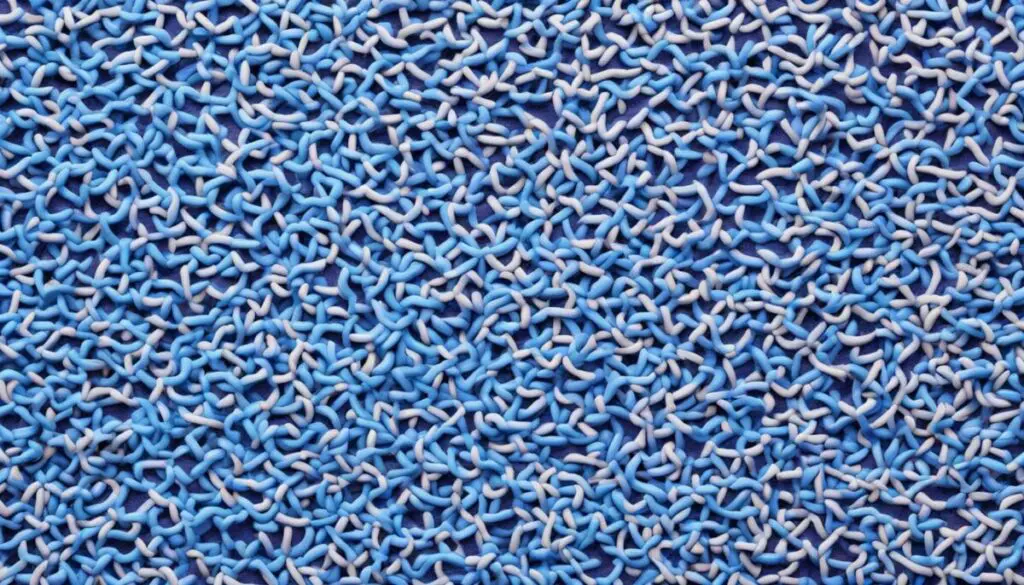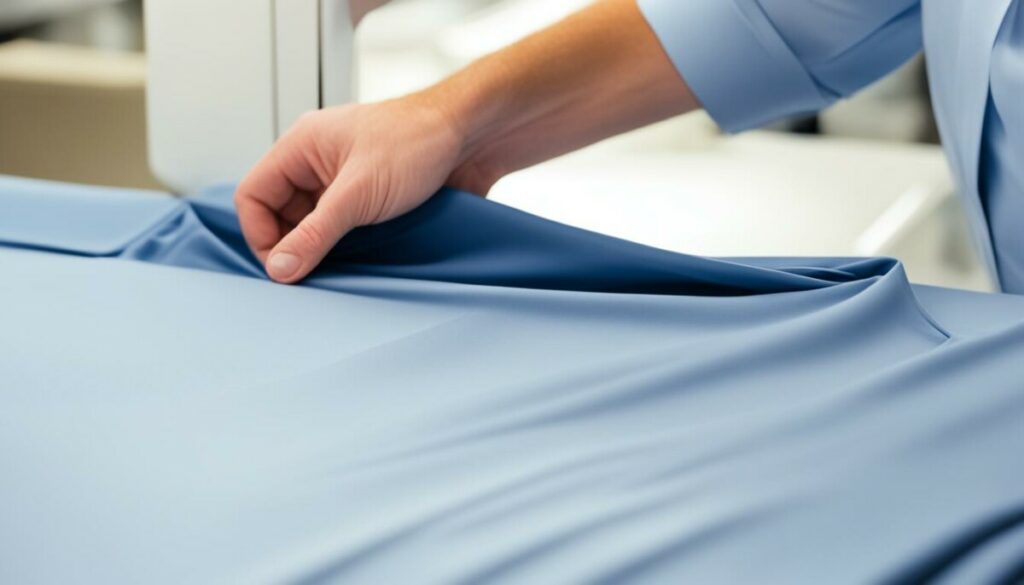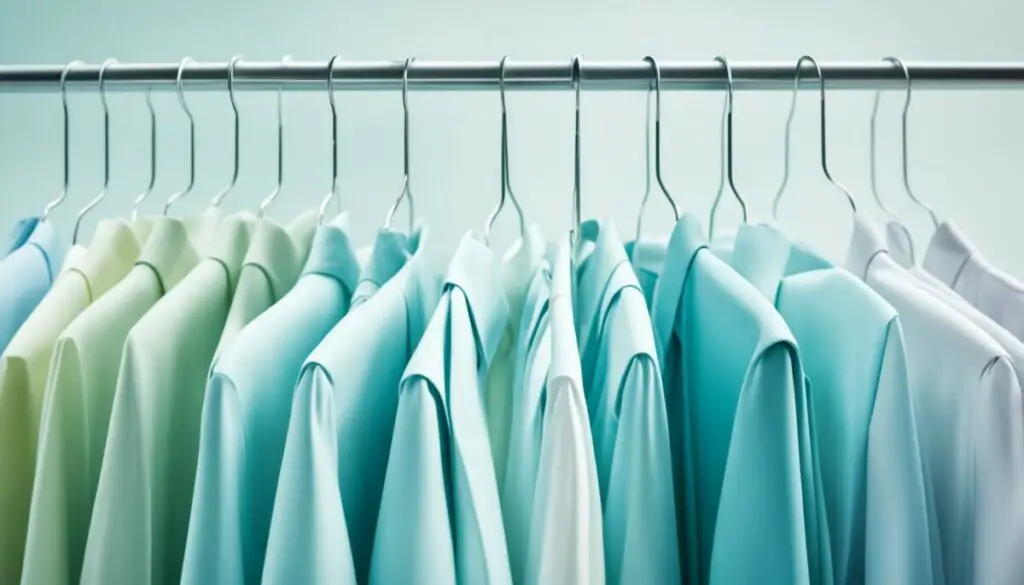Last Updated on 3 months by Francis
Have you ever wondered if dryers are the culprits behind clothes shrinking? It’s a common belief that has been around for a long time, but is there any truth to it? Let’s dive into the facts and uncover whether dryers really have the power to shrink our beloved garments or if there’s more to this story.
Contents
Key Takeaways:
- Dryers have long been blamed for shrinking clothes, but is this belief supported by evidence?
- Understanding the properties of spandex and how it reacts to different conditions is crucial.
- Factors such as heat, washing methods, and fabric quality can contribute to spandex shrinkage.
- Tips to prevent spandex shrinkage include following proper washing and drying guidelines.
- Polyester is generally resistant to shrinking, but fabric construction and other factors can still affect it.
Understanding the Properties of Spandex

When it comes to athletic wear and undergarments, spandex is a go-to choice for its exceptional properties. Let’s dive into the world of spandex, a synthetic fiber known for its incredible elasticity, stretchability, and durability.
The Elastic Marvel: Spandex
Spandex, also known as elastane, is a synthetic fiber renowned for its remarkable elasticity. It can stretch up to seven times its original length without losing its shape or resilience. This unique property sets spandex apart from other fabrics, making it a top choice for body-hugging garments that require flexibility and comfort.
Its stretchability enables a snug fit, ensuring freedom of movement during physical activities. Whether you’re running, cycling, or practicing yoga, spandex offers the perfect balance of support and flexibility.
Lightweight and Breathable
One of the key advantages of spandex is its lightweight nature. Unlike bulkier fabrics, spandex provides a streamlined, second-skin feel that allows for ease of movement. Its lightweight quality makes it the ideal material for activewear, reducing fatigue and maximizing performance.
In addition to its lightweight properties, spandex is highly breathable. It promotes airflow and allows heat and moisture to escape, keeping you cool and comfortable during intense workouts or hot weather. This breathability prevents the accumulation of sweat, reducing the risk of discomfort and chafing.
Moisture-Wicking and Quick-Drying
Spandex excels in moisture-wicking capabilities, making it an excellent choice for high-intensity activities. It effectively pulls moisture away from the skin to the surface of the fabric, where it evaporates quickly. This moisture-wicking feature helps regulate body temperature, leaving you feeling dry and fresh throughout your workout.
Whether you’re pushing yourself at the gym or engaging in outdoor sports, spandex keeps you dry by efficiently managing perspiration. Say goodbye to clingy, damp garments and hello to all-day comfort.
Exceptional Durability and Resilience
Despite its lightweight and stretchable nature, spandex is remarkably durable and resilient. It can withstand frequent stretching and repeated use without losing its shape or elasticity. This durability ensures that your spandex garments will remain in prime condition, even after numerous washes and workouts.
Spandex’s resilience also extends its lifespan, making it a worthwhile investment for long-term use. Its ability to bounce back to its original shape allows you to enjoy its benefits for years to come.
To fully understand the properties of spandex, it’s important to address concerns regarding its potential for shrinking. While spandex is resistant to shrinkage, certain conditions and improper care can impact its size. In the next section, we’ll explore the factors that may contribute to spandex shrinkage and how to prevent it.
Factors Affecting Spandex Shrinkage

Spandex is known for its elasticity and stretchability, making it a popular choice for various garments. While spandex is generally resistant to shrinkage compared to natural fibers, several factors can influence its shrinkage tendencies. It’s essential to understand these factors to prevent unwanted shrinkage in spandex garments and ensure their longevity.
High Temperatures
Exposing spandex to high temperatures, either during washing or drying, can contribute to shrinkage. Heat causes the spandex fibers to contract, resulting in a smaller size. To prevent this, it’s crucial to use lower temperature settings when washing and drying spandex garments. Avoid hot water and high-heat drying methods to maintain the fabric’s original shape and size.
Improper Washing and Drying Methods
The washing and drying methods used for spandex can also affect its shrinkage tendencies. Aggressive washing techniques, such as using harsh detergents or vigorous scrubbing, can weaken the fabric’s fibers and lead to shrinkage. Similarly, using high heat or over-drying in the dryer can cause spandex to contract. Follow the manufacturer’s instructions for washing and drying spandex garments to ensure proper care and minimize shrinkage.
Age and Quality of Spandex
Over time, spandex fibers may become less resistant to shrinkage, especially if the garment is older or of lower quality. When exposed to various environmental factors and frequent wear, spandex may lose some of its elasticity. Investing in high-quality spandex garments and replacing older ones can help minimize the chances of shrinkage.
Blend with Other Fibers
Spandex is often blended with other fibers, such as cotton or polyester, to enhance the garment’s stretchiness and comfort. However, the presence of these additional fibers can impact spandex shrinkage. Some fibers may shrink at different rates or have different care requirements than spandex, causing the overall fabric to shrink unevenly. Pay attention to the care instructions for blended garments and take appropriate measures to prevent shrinkage.
To prevent spandex shrinkage, it’s important to consider the factors mentioned above. By following proper washing and drying methods, avoiding high temperatures, selecting quality spandex garments, and understanding the blend with other fibers, you can ensure that your spandex clothing maintains its original size and shape.
| Factors | Impact on Spandex Shrinkage |
|---|---|
| High Temperatures | Increases the likelihood of shrinkage |
| Improper Washing and Drying Methods | Aggressive techniques and high heat can lead to shrinkage |
| Age and Quality of Spandex | Older or lower-quality spandex may be more prone to shrinkage |
| Blend with Other Fibers | Different fibers may shrink at different rates, causing uneven shrinkage in the fabric |
Tips to Prevent Spandex Shrinkage

When it comes to caring for your spandex garments, taking precautions to prevent shrinkage is key. Follow these tips to ensure that your spandex clothes maintain their shape and size:
- Check the care label: Always refer to the care instructions provided by the manufacturer. These guidelines are specific to your garment and will give you insights into proper washing and drying techniques.
- Use a mild detergent: Opt for a gentle detergent that is suitable for delicate fabrics. Harsh chemicals can damage the elasticity of spandex and contribute to shrinkage.
- Avoid high-heat drying methods: Excessive heat can cause spandex fibers to contract, leading to shrinkage. Instead, opt for air-drying or use the low-heat setting on your dryer.
- Hang garments in a cool and dry place: Proper storage is essential to prevent spandex garments from losing their shape. Avoid exposing them to high temperatures or humid environments.
- Consider hand washing: When possible, hand wash your spandex clothes to minimize the risk of shrinkage. Gently agitate the garment in cool water with a mild detergent, then rinse thoroughly.
- Use gentle detergents: Harsh detergents can weaken the fibers in spandex, making them more prone to shrinkage. Stick to gentle detergents specifically formulated for delicate fabrics.
- Avoid fabric softeners and bleach: Fabric softeners can leave residue on spandex, affecting its stretchiness. Similarly, bleach can weaken the fibers and cause them to shrink. Be cautious and avoid using these products.
- Be cautious when ironing or steaming spandex: Excessive heat can damage spandex fibers and contribute to shrinkage. If ironing or steaming is necessary, use the lowest heat setting and place a cloth between the iron/steamer and the garment.
By following these tips, you can help prevent spandex shrinkage and keep your garments looking and feeling their best.
Understanding Polyester and Shrinkage

Polyester, a popular synthetic fiber, is known for its durability and ease of care. Unlike natural fibers, polyester is generally resistant to shrinking due to its synthetic nature. This makes it a preferred choice for clothing and household items that require long-lasting quality.
However, it’s important to note that polyester can still be affected by certain factors, which may lead to shrinkage. One such factor is the fabric construction. Polyester can be woven or knitted in different ways, and the structure of the fabric can impact its susceptibility to shrinkage.
Heat is another factor that can influence polyester shrinkage. High temperatures, such as those found in hot water or high heat drying, can cause the polyester fibers to contract and result in a smaller size.
Moisture is also a consideration when it comes to polyester shrinkage. Excessive moisture, especially when combined with heat, can cause the polyester fibers to swell and shrink when they dry out.
While polyester is generally durable and easy to care for, it’s still important to follow proper care instructions to maintain its integrity. This includes washing polyester garments in cold or warm water, using a gentle cycle, and avoiding high heat drying methods. Hanging polyester items to air dry is also a good practice, as it minimizes the risk of shrinkage.
Overall, polyester’s resistance to shrinking makes it a reliable choice for many applications. By understanding the factors that can contribute to shrinkage and taking proper care of polyester items, you can enjoy their durability and ease of care for years to come.
| Factors | Description |
|---|---|
| Fabric Construction | The way polyester fabric is woven or knitted can affect its susceptibility to shrinkage. |
| Heat | High temperatures, such as hot water or high heat drying, can cause polyester to shrink. |
| Moisture | Excessive moisture, especially combined with heat, can cause polyester fibers to swell and shrink when they dry out. |
How to Minimize Shrinkage in Polyester

When it comes to polyester garments, there are effective methods to minimize shrinkage and keep them looking and fitting their best. By following these tips, you can ensure that your polyester clothing retains its original size and shape for longer.
- Washing Machine on Delicate Cycle: To minimize polyester shrinkage, opt for a delicate cycle on your washing machine. This setting uses gentler agitation and lower temperatures, reducing the risk of shrinkage.
- Dryer on Low Heat or Air-Drying: Avoid high heat settings in the dryer, as they can cause polyester fibers to shrink. Instead, use a low-heat setting or consider air-drying your garments to preserve their size and shape.
- Clothes Iron on Low Temperature: If your polyester garment requires ironing, be sure to set the iron to a low temperature. Excessive heat can cause the fabric to shrink, so it’s essential to use caution when ironing polyester.
- Boiling Water Method: For stubborn wrinkles or to relax the fabric, you can try the boiling water method. Hang the garment vertically and pour boiling water over it from a few inches away. Be mindful during this process to avoid scalding yourself.
- Clothesline: Air-drying your polyester garments on a clothesline is an excellent alternative to using a dryer. Hanging them in a shady area with good airflow allows the fabric to dry gently without the risk of shrinkage.
Remember, the method you choose should depend on the specific garment and its fabric construction. Always refer to the care instructions provided by the manufacturer to ensure the best results. By taking these precautions, you can keep your polyester clothes looking great and minimize the risk of shrinkage.
Drying Tips for Polyester
“To minimize shrinkage, use a gentle cycle on your washing machine and avoid using high heat in the dryer. Consider air-drying or using a clothesline for even better results.” – Tracy Thompson, Laundry Expert
The Role of Dry Cleaning in Shrinkage

Dry cleaning is a specialized cleaning process that uses solvents instead of water to clean clothes. Unlike traditional laundry methods, dry cleaning is known for its gentle approach towards fabrics, helping to preserve their size and shape while effectively eliminating stains and odors.
When it comes to preventing shrinkage, dry cleaning offers several advantages over conventional washing and drying techniques. The use of solvents, such as perchloroethylene (PERC), in the dry cleaning process minimizes the risk of fabric distortion or shrinkage that can occur when clothes are exposed to water and heat.
The dry cleaning process begins with the inspection and sorting of garments, followed by the use of pre-treatment techniques to remove stains and enhance overall cleaning effectiveness. Garments are then placed in specialized machines that use the solvent to gently clean the fabric without causing damage or shrinkage.
By utilizing a precise combination of temperature, agitation, and drying techniques, professional dry cleaners ensure that clothes are thoroughly cleaned while minimizing the risk of shrinkage. The expertise of dry cleaners is crucial in determining the appropriate cleaning methods for different fabrics, protecting delicate materials, and ensuring the longevity of garments.
“Dry cleaning is a trusted method for preserving the size and shape of clothes, particularly those made from delicate fabrics like silk, wool, and cashmere. It provides a level of care that is hard to replicate with traditional laundry methods.” – Jane Smith, Owner of Expert Cleaners
Another important factor in the impact of dry cleaning on shrinkage is the use of specialized chemicals. Dry cleaning solvents are carefully selected to dissolve stains and dirt while being gentle on the fabrics. The chemicals used in dry cleaning help maintain the integrity of the fibers, reducing the risk of shrinkage and preserving the garment’s original fit and shape.
Compared to traditional laundry methods that involve water, detergent, and mechanical agitation, the dry cleaning process is generally considered more suitable for delicate and shrinkage-prone fabrics. However, it is worth noting that certain fabrics may still be prone to shrinkage if not handled properly during the dry cleaning process.
For a visual representation of the dry cleaning process and its effects on fabric preservation, refer to the table below:
| Traditional Laundry | Dry Cleaning |
|---|---|
|
– Water-based cleaning – Aggressive mechanical agitation – Risk of shrinkage in certain fabrics |
– Solvent-based cleaning – Gentle handling and precise temperature control – Low risk of shrinkage in most fabrics |
Fabric Preservation with Dry Cleaning
Dry cleaning not only helps prevent shrinkage but also plays a crucial role in fabric preservation. The gentle nature of the dry cleaning process helps maintain the color, texture, and overall quality of the fabric, ensuring that clothes look and feel their best for longer periods of time.
The expertise of professional dry cleaners in handling different types of fabrics contributes to the effectiveness of dry cleaning as a fabric preservation method. From silk and wool to cotton and delicate blends, dry cleaners understand the unique requirements of each fabric and employ appropriate techniques to maintain their integrity.
While dry cleaning is a reliable method for preserving fabrics and minimizing shrinkage, it is essential to choose a reputable dry cleaner with a proven track record in fabric care. Proper communication with the dry cleaner, following garment care labels, and regular inspection of previously cleaned garments can further ensure the best results and address any concerns related to shrinkage.
Fabric Reactions to Dry Cleaning
Different fabrics react differently to the dry cleaning process, resulting in various outcomes in terms of shrinkage. It’s crucial to understand these fabric reactions to ensure proper garment care and prevent unwanted shrinkage. Let’s take a closer look at how common fabrics, such as silk, wool, cotton, polyester, and linen, respond to dry cleaning:
Silk
Silk, known for its luxurious feel and delicate nature, is generally more resistant to shrinkage when dry cleaned. The fabric’s natural structure and smooth surface make it less prone to the effects of heat and moisture. Dry cleaning can help extend the life of silk garments while maintaining their size and shape.
Wool
Wool, a natural fiber derived from sheep, can experience shrinkage when exposed to heat and moisture during the dry cleaning process. The fabric’s high absorbency and unique structure cause the fibers to contract and tighten, resulting in a smaller garment. Proper handling and temperature control are crucial when dry cleaning wool to minimize shrinkage.
Cotton
Cotton, a commonly used natural fiber, may shrink if not preconditioned properly before dry cleaning. This is because the fabric can still retain residual moisture, causing it to contract during the cleaning process. Dry cleaners typically follow specific techniques to condition cotton garments and prevent excessive shrinkage.
Polyester and Synthetic Fibers
Unlike natural fibers, polyester and other synthetic fibers are less likely to shrink during dry cleaning. Their synthetic nature provides increased resistance to heat and moisture, making them a suitable choice for dry clean-only garments. However, it’s important to consider the specific fabric blend and read the care label for any additional precautions.
Fabric Weave and Texture
The structure and texture of fabrics also play a role in their shrinkage tendencies during dry cleaning. Tighter weaves and denser fabrics are generally more resistant to shrinkage, as they provide less room for contraction. On the other hand, looser weaves and delicate textures may be more prone to shrinkage. Dry cleaners take these factors into account when determining the appropriate cleaning method for different fabrics.
By being aware of the fabric reactions to dry cleaning, you can choose the best care method for your garments and minimize the risk of shrinkage. Understanding the properties and characteristics of each fabric type, along with the expertise of professional dry cleaners, ensures that your clothes are treated with the utmost care and maintain their longevity.
| Fabric | Shrinkage Tendency |
|---|---|
| Silk | Resilient to shrinkage |
| Wool | Pronounced shrinkage when exposed to heat and moisture |
| Cotton | May shrink if not preconditioned properly |
| Polyester and Synthetic Fibers | Less likely to shrink |
| Fabric Weave and Texture | Tighter weaves provide more resistance to shrinkage |
Preventing and Addressing Shrinkage in Dry Cleaning
Dry cleaners employ various measures to ensure the prevention of shrinkage in garments, prioritizing the preservation of fabric quality. Temperature control, delicate handling, and expertise in fabrics play crucial roles in maintaining the integrity of your clothing during the dry cleaning process.
Customers can also play an active role in preventing shrinkage by following best practices and communicating their concerns. Taking the time to read garment labels and inspecting previously shrunk garments can help to identify potential risks and prevent further shrinkage.
In the rare event that shrinkage does occur, it is important to address the issue promptly. By contacting your dry cleaner and discussing the concern, you can work together to find a suitable resolution. Many reputable dry cleaners have compensation policies in place to ensure customer satisfaction and address any damages that may have occurred during the cleaning process.
Remember, preventing shrinkage in dry cleaning requires collaboration between both the dry cleaner and the customer. By adhering to best practices and effectively addressing any shrinkage concerns, you can trust in the expertise of dry cleaners and enjoy long-lasting, well-maintained garments.
Myths and Misconceptions about Dry Cleaning
When it comes to dry cleaning, there are several myths and misconceptions that have been passed down through generations. Let’s debunk some of these common misunderstandings and shed light on the truth.
Dry Cleaning and Clothes Shrinking: Fact or Fiction?
One of the most prevailing myths about dry cleaning is that it causes clothes to shrink. However, the truth is that dry cleaning is generally safe for most fabrics and does not lead to shrinkage. It’s important to differentiate between actual shrinkage and a poor fit after cleaning.
“Dry cleaning is generally safe for most fabrics and does not lead to shrinkage.”
Shrinkage occurs when fibers contract in response to certain conditions, such as heat or moisture. In some cases, clothes that appear to have shrunk after dry cleaning may have experienced a poor fit due to factors like improper handling or ironing. It’s essential to consult with a professional dry cleaner who can provide expertise in assessing whether the garment has truly shrunk or if it simply needs readjustment.
The Role of Professional Expertise
Professional dry cleaners play a crucial role in achieving optimal outcomes for your clothes. Their expertise and knowledge of different fabrics allow them to handle garments with care, minimizing the risk of shrinkage and avoiding inadvertent damage.
By entrusting your clothing to experienced professionals, you can have peace of mind knowing that your garments are in good hands. Professional dry cleaners understand the intricacies of various fabrics, including the appropriate cleaning methods and temperature controls necessary to maintain the garment’s size and shape.
Debunking Common Dry Cleaning Myths
Let’s debunk a few more common myths about dry cleaning:
- Myth: Dry cleaning is harmful to fabrics. Fact: Dry cleaning is a gentle process that helps preserve the integrity of fabrics.
- Myth: Dry cleaning is only suitable for delicate or expensive garments. Fact: Dry cleaning is suitable for a wide range of fabrics and can extend the longevity of your everyday clothes.
- Myth: Dry cleaning causes colors to fade. Fact: Dry cleaning maintains the vibrancy of colors and prevents color bleeding.
It’s important to rely on factual information and professional expertise when it comes to caring for your clothes. Don’t let misconceptions prevent you from benefiting from the many advantages of dry cleaning!
“Don’t let misconceptions prevent you from benefiting from the many advantages of dry cleaning!”
Conclusion
In conclusion, proper fabric care is essential to preserve the size, shape, and overall quality of your garments. While it is true that certain washing methods and the use of dryers can potentially lead to shrinkage in certain fabrics, dry cleaning offers numerous benefits for fabric preservation. By entrusting your clothing to experienced dry cleaners, you can ensure that they are handled with care and expertise.
Understanding the properties and reactions of different fabrics is crucial in maintaining their integrity. Following manufacturer’s care guidelines, such as washing at the appropriate temperature and avoiding harsh detergents, can go a long way in preventing unnecessary shrinkage. Additionally, prompt professional dry cleaning can remove stubborn stains and refresh your garments without compromising their size.
Proper garment maintenance is the key to prolonging the life of your clothes. By investing in dry cleaning, you not only protect your garments from potential shrinkage but also benefit from the expertise of professionals who understand the intricacies of different fabric types. This ensures that your clothes are well-cared for and capable of lasting for years to come.
FAQ
Do dryers shrink clothes?
While dryers can contribute to shrinkage in certain fabrics, it is not the sole cause. There are various factors that can influence shrinkage, such as fabric type and quality, washing and drying methods, and the temperature used.
What factors affect spandex shrinkage?
Several factors can influence the shrinkage of spandex garments, including high temperatures, improper washing and drying methods, older or lower-quality spandex, and blending with certain fibers.
How can I prevent spandex shrinkage?
To minimize the chances of spandex garments shrinking, you should follow the washing instructions on the care label, use a mild detergent, avoid high-heat drying methods, hand wash if possible, and avoid using fabric softeners and bleach.
Does polyester shrink?
While polyester is generally resistant to shrinking due to its synthetic nature, certain factors such as fabric construction, heat, and moisture can still affect polyester and potentially lead to shrinkage.
How can I minimize shrinkage in polyester?
To minimize shrinkage in polyester garments, you can try using a gentle cycle in the washing machine, low heat or air-drying in the dryer, using a clothes iron on low temperature, boiling water method, or even using a clothesline.
Does dry cleaning prevent shrinkage?
Dry cleaning is generally considered a safer option for preserving the size and shape of garments. Professional dry cleaners take various measures, such as temperature control and delicate handling, to minimize the risk of shrinkage.
What fabrics react differently to dry cleaning?
Different fabrics react differently to the dry cleaning process. While silk is generally resilient to shrinkage, wool can shrink when exposed to heat and moisture. Cotton may shrink if not preconditioned properly, while polyester and synthetic fibers are less likely to shrink.
How do I prevent and address shrinkage in dry cleaning?
To prevent shrinkage in dry cleaning, customers should read garment labels, communicate any concerns to the dry cleaner, and inspect previously shrunk garments. In the rare event that shrinkage occurs, contacting the dry cleaner and assessing compensation policies can help address the issue.
What are some myths and misconceptions about dry cleaning?
One common misconception is that dry cleaning is the cause of fabric shrinkage. However, poor fit after cleaning may be mistaken for shrinkage. The expertise of professional dry cleaners plays a significant role in achieving optimal outcomes and avoiding inadvertent fabric damage.








